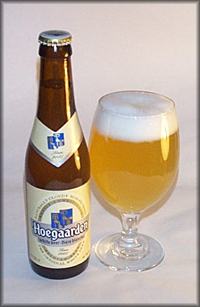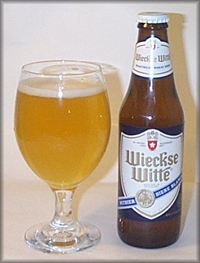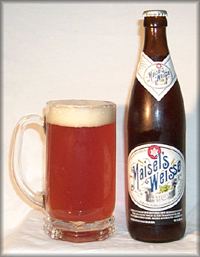Sponsored By Hoegaarden

An exciting new addition this year is the white bar. On this bar we shall bring all the worlds wheat beers together so they can be compared and savoured. Many countries produce wheat beers and we hope to show case as many as possible. Read on to find out all you need to know about this beer style!
 One of the most successful beer
styles of the last three decades has been
Wheat
Beer. During this period it
has grown to be a substantial part of the German and Belgian, then
Dutch and American beer markets. In the last few years we have seen
several British brewers taking up the theme and producing their own
varieties. In celebration of these great summer beers, GBBF 1999
features a special bar, the
"White
Bar", dedicated to the
presentation of wheat
beers from around the
world.
One of the most successful beer
styles of the last three decades has been
Wheat
Beer. During this period it
has grown to be a substantial part of the German and Belgian, then
Dutch and American beer markets. In the last few years we have seen
several British brewers taking up the theme and producing their own
varieties. In celebration of these great summer beers, GBBF 1999
features a special bar, the
"White
Bar", dedicated to the
presentation of wheat
beers from around the
world.
Wheat Beers are usually made from a mix of wheat and barley, sometimes with spices. The beer undergoes a primary top fermentation, like an ale and is usually re-seeded for secondary fermentation in bottle or keg. Unless the beer is filtered the result is often cloudy with yeast - and all the better for it ! Not all wheat beers are white but enough of them are associated with this colour for us to transfer the appellation to the bar.
We will be featuring many examples of the Witbier, or Biere Blanche style, revived in the 1960’s by Pierre Celis in Belgium with his Hoegaarden Blanche. Many Belgian, Dutch and American breweries make beer in this style and we hope to bring you some of the best. Witbier is made from a mash of barley and unmalted wheat, often utilising spices once found in the Dutch empire such as coriander and Curacao orange peel. The beers generally have a firm grainy quality, often with orange and apple notes. Most witbiers are just under 5% ABV.
The next great group of wheat beers to be featured is certainly the biggest. The Bavarian Weizenbier, or Weisse, style has become a firm favourite in South Germany and is widely copied elsewhere. These refreshing beers are made from barley and malted wheat - no added spices. They often have a lemony character and the taste of cloves and bananas can be found in several of the more traditional brands. These tastes are largely a result of the yeast used in the primary fermentation but additional taste and character is gained from the secondary yeast. These beers’ reputation as something of a health food have helped them gain popularity amongst women drinkers in particular. Most Weizenbiers are 5% ABV. Beware Schneider Brewery’s wonderfully dangerous Aventinus - an 8% ABV dark wheat beer.
A distinct form of German Wheat Beer is the famous Berliner Weisse, now only made by a couple of breweries. This beer is characterised by a low alcohol content, a sharp acidity and a lactic fermentation giving a delicate fruitiness. A tradition has now evolved whereby this beer is usually served with a dose of woodruff or raspberry syrup, these turn the beer a bright green or red and provide some sweetness to counter the beer’s natural sharpness. Some of us are more than happy with the straight product, but all tastes will be accommodated ! ABV from 2.5%.
 A further category are the ales
brewed with high wheat content which drop clear(ish) and combine
elements of both the ale and the wheat beer traditions. Many of the
UK varieties fall in this category. Beers of this style are sometimes
referred to as Wheaten
Ales in the USA, it remains
to be seen if the term will get picked up over here. Hop Back
Thunderstorm is a good example, as is Pyramid Wheaten Ale from
Seattle. An interesting one to try at the bar is Pilgrim’s
Springbock. Compare it with the Schneider Weisse
(Weizenbier)
it was modelled on - find those bananas and cloves ! Temperatures of
cask Wheaten
Ales will be kept lower than
usual for Real Ales.
A further category are the ales
brewed with high wheat content which drop clear(ish) and combine
elements of both the ale and the wheat beer traditions. Many of the
UK varieties fall in this category. Beers of this style are sometimes
referred to as Wheaten
Ales in the USA, it remains
to be seen if the term will get picked up over here. Hop Back
Thunderstorm is a good example, as is Pyramid Wheaten Ale from
Seattle. An interesting one to try at the bar is Pilgrim’s
Springbock. Compare it with the Schneider Weisse
(Weizenbier)
it was modelled on - find those bananas and cloves ! Temperatures of
cask Wheaten
Ales will be kept lower than
usual for Real Ales.
In addition to these main groups we hope to have a few Wheat Beer specialities made with different grain mixes or brewed with other unusual adjuncts - anyone for gooseberry? The only wheat beers we definitely will not have, apart from some poor pasteurised products, are the lambics as these are a different sort of drink altogether - you’ll find some great ones on the separate Belgian & Dutch Bar.
![]()
Menu Page ~ CAMRA Home Page ~ British Beer ~ Imported Beer ~ Cider & Perry ~ Entertainment ~ White Bar ~ Tasting Sessions ~ Opening Times and Prices ~ Family Room ~ CAMRA Members Area ~ CBOB ~ Festival Map ~ Other Attractions ~ Food Range ~ Corporate Hospitality ~ Other Information
The views expressed on this page are not necessarily those of the Campaign for Real Ale.
©The Campaign for Real Ale 1999.
![]() E-mail the webmaster with your queries and comments.
E-mail the webmaster with your queries and comments.